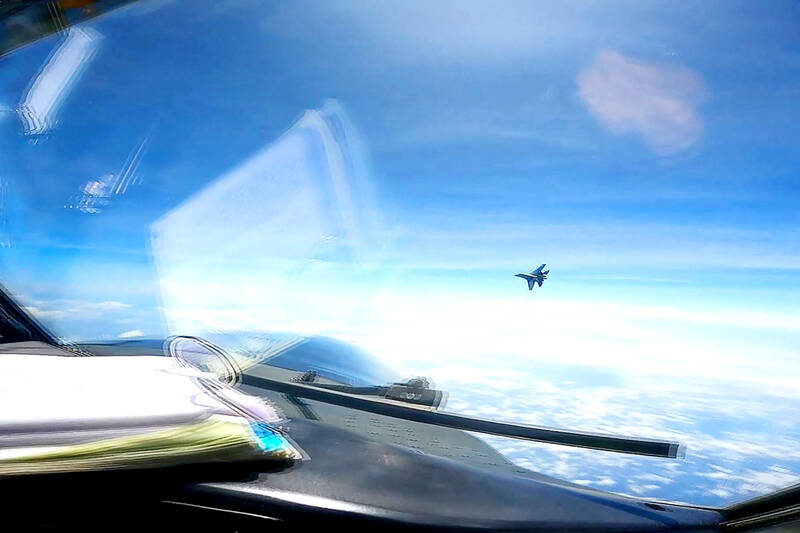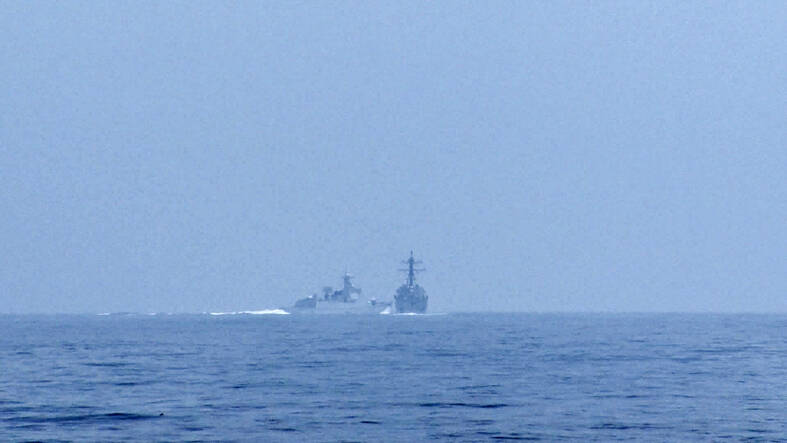When a Chinese warship came within 136 meters of a US destroyer in the Taiwan Strait on Saturday and forced it to slow down, it was the second time in as many days that Chinese and US Military personnel came close to a major incident.
Late last month, a Chinese fighter jet flew in front of an American warplane over the South China Sea, drawing a reprimand from the US.
After the warship encounter on Saturday, the White House accused China of “increasing aggression.” China has said that such US military activity in international waters is “deliberately creating risks.”

Photo: AFP
CHINA PUSHING BACK
Under President Xi Jinping (習近平), China has begun carrying out what US officials say is one of the largest peacetime military buildups in history.
Beijing is using its growing military might and economic clout to push back decades-old US military dominance in Asia. China views the US as an outsider interfering in a region in which it sees itself as a force for peace and stability.

Photo: Reuters
A particular source of tension are “freedom of navigation” patrols in which the US and its allies escort naval vessels through the Taiwan Strait and the South China Sea.
The US maintains that such patrols protect the right of all nations to sail in international waters.
China has complained about US ships and aircraft close to islands it controls, claims or has built and turned into military installations in the Taiwan Strait and in the South China Sea. The People’s Liberation Army Navy (PLAN) usually pursues American ships.
Some analysts say this has encouraged Chinese military commanders to act more assertively against foreign military ships and aircraft.
Defense expert Jennifer Parker said, “I think what we’re seeing is a general incentive, perhaps even an incentive scheme, for (PLA) unit commanders to go on the offensive when the opportunity arises, which is at the unit level,” but encourages more reckless behavior.”
Other recent incidents in the South China Sea have seen a Chinese coast guard ship directing a “military-grade laser” at a Philippine vessel in February, and Vietnam last month demanding Beijing remove survey vessels from its waters.
China said both incidents were legitimate and normal.
Its defense ministry did not immediately comment on claims that it was encouraging more aggressive behavior.
This PLA approach increases the likelihood of a confrontation that could turn into an armed conflict, says Derek Grossman, senior defense analyst at the US think tank RAND Corporation.
“In my view, this is the No. 1 scenario that leads the US and China to war, and it has less of Beijing seizing a facility in the disputed South China Sea or invading Taiwan,” he said.
COLLISION COURSE
To make matters worse, the US and China have different views on the source of the problem. The US sees China as disrupting the status quo with its threats against Taiwan, the self-governing island that China claims as its own, and its territorial claims over the resource-rich South China Sea.
The answer from the US perspective is to continue to assert its right of sailing and flying over China.
Tong Zhao, a visiting scholar at Princeton University’s School of Public and International Affairs, said China’s ruling Communist Party views the US actions as a provocation and believes that US efforts for military dominance are the real cause of threats in the region.
“Chinese officials generally do not see China’s own behavior as contributing to the risk,” he said. “And so their argument is that China can only reduce the risk by increasing its military measures to counter America’s aggressive behaviors and to make the United States feel genuinely concerned about events. And only then the United The United States will ultimately take the necessary measures to reduce the risk.”
NO COMMUNICATION
Add to this another problem: the lack of reliable means of communication between the two armies.
The US military has long been pushing China for open lines of communication with the PLA — at both senior and lower levels — to reduce the risk that accidents could lead to military flare-ups.
In contrast, US officials say, China’s leaders have been slow to establish military contacts and quickly shut them down during periods of diplomatic tension.
China suspended several high-level military talks with the Pentagon after former US House Speaker Nancy Pelosi visited Taiwan last summer and the defense chiefs of the two countries shot down a Chinese spy balloon over US airspace.
A senior US defense official told Reuters on condition of anonymity that China has declined or not responded to more than a dozen requests to speak with the Pentagon and about ten working-level engagement requests since 2021. .
China’s Defense Ministry did not immediately respond to requests for comment.
Analysts say China is wary of military talks that could give the US more insight into the PLA’s operations. Chinese leaders would also like to keep US-China discussions focused on trade and economic issues.
However the threats are not imaginary.
An American spy plane made an emergency landing on Hainan Island in 2001 after a collision with a Chinese fighter jet.
A Chinese pilot died and Beijing detained the 24-man American crew for 11 days, releasing them only after Washington sent a letter saying it was “very sorry.”

May 11 to May 18 The original Taichung Railway Station was long thought to have been completely razed. Opening on May 15, 1905, the one-story wooden structure soon outgrew its purpose and was replaced in 1917 by a grandiose, Western-style station. During construction on the third-generation station in 2017, workers discovered the service pit for the original station’s locomotive depot. A year later, a small wooden building on site was determined by historians to be the first stationmaster’s office, built around 1908. With these findings, the Taichung Railway Station Cultural Park now boasts that it has

The latest Formosa poll released at the end of last month shows confidence in President William Lai (賴清德) plunged 8.1 percent, while satisfaction with the Lai administration fared worse with a drop of 8.5 percent. Those lacking confidence in Lai jumped by 6 percent and dissatisfaction in his administration spiked up 6.7 percent. Confidence in Lai is still strong at 48.6 percent, compared to 43 percent lacking confidence — but this is his worst result overall since he took office. For the first time, dissatisfaction with his administration surpassed satisfaction, 47.3 to 47.1 percent. Though statistically a tie, for most

As Donald Trump’s executive order in March led to the shuttering of Voice of America (VOA) — the global broadcaster whose roots date back to the fight against Nazi propaganda — he quickly attracted support from figures not used to aligning themselves with any US administration. Trump had ordered the US Agency for Global Media, the federal agency that funds VOA and other groups promoting independent journalism overseas, to be “eliminated to the maximum extent consistent with applicable law.” The decision suddenly halted programming in 49 languages to more than 425 million people. In Moscow, Margarita Simonyan, the hardline editor-in-chief of the

Six weeks before I embarked on a research mission in Kyoto, I was sitting alone at a bar counter in Melbourne. Next to me, a woman was bragging loudly to a friend: She, too, was heading to Kyoto, I quickly discerned. Except her trip was in four months. And she’d just pulled an all-nighter booking restaurant reservations. As I snooped on the conversation, I broke out in a sweat, panicking because I’d yet to secure a single table. Then I remembered: Eating well in Japan is absolutely not something to lose sleep over. It’s true that the best-known institutions book up faster